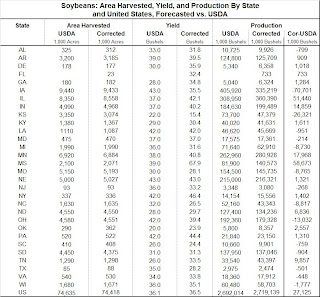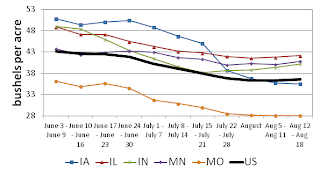I was way off on corn, but as discussed last week, you could see this coming (absolute vs. percent deviations of the model structure), however, I was very close on both soybean (within 0.3% of reported production) and cotton (within 0.5% of production ). Things haven't changed much since that time.
I've put up a state by state comparison with USDA so you can look more closely at how the states compare to USDA estimates. I've also put up a graph showing the harvesting rate coming out of the model compared to USDA. If I used their harvesting rate I would be even further off on production than I am now (the model is specifically designed to incorporate harvesting losses). I was a bit surprised at the number of acres they held into production but with $8 corn and $30 harvesting costs, it doesn't take many bushels to make harvest worth while.
Corn Yield: 139.2 bu/ac
Corn Production: 11,957 million bushelsUSDA Production: 10,773 million bushels
Soybean Yield: 36.5 bu/ac
Soybean Production: 2,719 million bushels
USDA Production = 2,692
Cotton Yield: 821 lbs/ac
Cotton Production 17.593 million bales
USDA Production = 17.650 million bales
I've been asked why I don't fix the maize model if I know it is going to be wrong (re-specify it with % deviations). This is a very good point. My only reason is I don't like to change the model during the growing season most years as in other situations I've found I would have made inappropriate adjustments and the model was doing just fine (not the case this year for maize!). Secondly this is all for fun at the moment so to think about the best way to re-estimate the equations in short order might take away from my day job.

Notice the numbers for Oklahoma cotton. The large difference is a lack of proper synchronization between the harvesting equation and the yield equation. So the harvesting falls off rapidly but this increases the yield at a pace which isn't realistic and thus you end up with production which is far too high.
Here, the US harvesting rate is holding at just over 90%. We saw much lower harvesting rates in 1988 and 1993 but the argument goes that the number and location of livestock was different and we won't see the same type of maize chopping we did during those years.













No comments:
Post a Comment